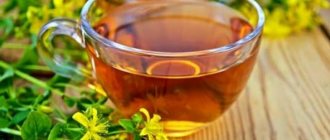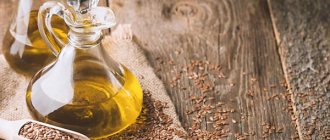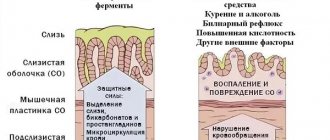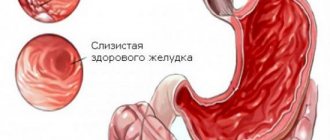Causes of infection
Once in the body, Helicobacter infection has a detrimental effect on the walls and mucous membrane of the stomach. The process of damage and the development of a superficial form of gastritis immediately begins. At the beginning, the disease does not manifest itself in any way.
The erosive form occurs when small bleeding erosion wounds form on areas of the mucous membrane affected by infection. If the fight is not started in time, the disease will transform into chronic mixed gastritis.
As a result of the influence of harmful bacteria, the blood vessels become thinner and begin to bleed. If the disease has entered the described phase, it means that a hemorrhagic form has developed. This is a serious disorder that requires constant medical supervision.
When the hypertrophic variety arises, the walls of the stomach are deformed and benign formations appear, cysts or polyps are formed. If there is a lack of treatment, degeneration can occur.
The modern rhythm of life favors the formation of the disease. Lack of time and quick snacks on the run, fast food and overeating before bed - these factors negatively affect the functioning of the digestive system, in particular the stomach. There are many causes of the disease. Mixed gastritis can appear due to exposure to chemical elements, for example, alcohols, acids, alkalis. Vinegar has a negative effect. The use of a number of medications opens the beginning of the onset of the disease.
What are the dangers of gastritis - complications
All types of gastritis, if not treated, are dangerous with complications of varying severity. The most common are:
- acute lack of vitamins, especially group B;
- Iron-deficiency anemia;
- dehydration of the body.
Prolonged increased gastritis, especially if it is accompanied by nausea and severe discomfort, can lead to anorexia and other eating disorders. Such patients experience severe weight loss due to a complete lack of appetite or fear of eating. The changes are so pronounced that a change in metabolism occurs, and nutrients from food, even if they are supplied in sufficient quantities, are no longer absorbed from the digestive tract.
With certain types of gastritis, life-threatening complications may occur:
- internal bleeding (occurs more often with erosive gastritis);
- peritonitis (develops with purulent forms of gastritis);
- pancreatitis;
- stomach ulcer.
All types of inflammation in the stomach are dangerous to varying degrees in terms of the formation of malignant tumors. That is why patients with this diagnosis are recommended to undergo a systematic examination by a gastroenterologist.
Diagnostics
Making a diagnosis of a disease takes place in a number of stages. There are several reasons for changes in the structure of the mucous membrane; the following types of examinations are required:
- Clinical. At this stage, an anamnesis is collected, the patient’s complaints are listened to, and an initial examination is performed. Based on the collected information, an intermediate diagnosis is made.
- Laboratory. A general urine test and a blood chemistry test to check for the presence of antibodies to selected infections.
- Fibrogastroduodenoscopy. During the procedure, the inner surface of the esophagus and stomach is examined.
- Probing. Taking a scraping from the gastric mucosa, collecting gastric juice to identify the causative agent of the pathology
Features of the course of mixed gastritis
With a mixed form of the disease, the dominant types of gastritis can be distinguished:
- predominance of the superficial type - pathological processes occur in the upper layer of the mucous membrane, muscles are not involved in the process;
- atrophic course of gastritis - the next stage of inflammation, during which the gastric glands contract, often progressing to the chronic stage (observed with bacterial damage);
- hemorrhagic type of gastritis - often observed in people with thinned vessels in the stomach; the disease is provoked by mechanical and chemical factors, including drug treatment;
- hypertrophic type of disease - the diagnosis is made if thickening of the walls of the glands is observed, which subsequently leads to the formation of cysts.
Mixed gastritis can occur in chronic or acute form. The latter is observed under short-term exposure to negative factors.
Treatment options
Symptoms and treatment of the disease depend on the incoming forms. If you immediately contact a doctor and prescribe medical therapy, the disease can be minimized in two to three days. Severe forms require a long time to recover.
Medication
It is appropriate to treat all signs of the disease; a comprehensive approach is chosen. The following are used in wrestling:
- Antacids - normalize the acidity of gastric juice (Phosphalugel, Maalox, Rennie). Usually prescribed in the presence of erosions.
- Anti-inflammatory drugs help destroy inflammation (Ibuprofen, Diclofenac).
- Antispasmodics – relieve pain (No-shpa, Papaverine).
- Enzyme preparations - taken to control the level of enzyme formation (Creon).
In many cases, antibiotics are prescribed.
Important: you should not prescribe treatment for yourself or choose medications without consulting a doctor. This will lead to undesirable consequences, even death.
Traditional methods
Treatment with “grandmother’s” remedies shows good results. It is advisable to combine them with medications under the supervision of the attending physician.
As additional therapy, infusions of yarrow herbs, calendula and shepherd's purse, decoctions of angelica, nettle and plantain are taken. Propolis and sea buckthorn oil are used as a healing agent.
Treatment with potato juice
Juice from chopped potatoes is considered cheap and easy to prepare. The drink has a beneficial effect on the mucous surface of the organ, normalizing the acidity of the stomach contents, helping to eliminate the taste of bitterness in the mouth and involuntary contractions of the stomach walls, and slightly increases the pepsin content.
To prepare the medicine, you should take a large potato, wash it thoroughly, and scrape off the skin. Grind on a plastic grater and squeeze through a clean piece of gauze. The volume will yield 60-70 milliliters of juice. Add a teaspoon of starch to it and mix. Drinking the mixture is prescribed twice a day. If acidity is high, 10-15 minutes before meals; if acidity is low, the interval should be 30-40 minutes. The period of use lasts up to ten to fourteen days. For prevention, resume taking it after a month. This mixture has the effect of a mild laxative. Taking “grandmother’s” medicine is completely harmless, does not threaten unexpected consequences and helps digestion.
Fresh cabbage juice exhibits similar properties. Before taking it, it should stand for three hours at a temperature of 18-22 degrees.
Healing with honey
Honey in combination with softened butter and aloe juice has an effective effect. To mix, take 200 g of all ingredients. Aloe juice is squeezed out after the leaves have been left in a dry place without access to sunlight for several days. It is better to place them in the refrigerator, after wrapping them in thick paper, and keep them for the required time at a temperature near 0 degrees.
The mixture is prescribed to be taken at a dose of 30 milligrams 20 minutes before starting a meal. Keep in the cold, warming up the required amount before taking.
If acidity is high, honey is taken one and a half hours before meals in the amount of two teaspoons. For greater effect, it is advisable to add an equal amount of softened butter. If the acidity is low, add one or two drops of lemon juice to the main ingredient.
Treatment of mixed gastritis using traditional medicine methods offers various mixtures based on honey. For example, a honey cocktail with milk and mumiyo shows good results with high acidity. Stir twenty-five grams of honey in a glass of heated milk, and after cooling, add 0.2 g of mumiyo. Drink 200 g in the morning and before bed for four weeks.
Collection of medicinal herbs in the fight against illness
To prepare the decoction you will need three parts of St. John's wort and 1 part each of wormwood, calendula, immortelle and plantain. Pour 70 g of dry mixture with 300 milligrams of heated water and keep in a steam bath for 20 minutes. It is recommended to drink the infusion at a dose of 60 milliliters, three to four times a day, 40 minutes before meals.
Propolis tincture
It is possible to buy it ready-made at a pharmacy, but it is advisable to prepare it yourself. 50 g of propolis is poured with half a liter of diluted alcohol and left at a temperature of 18-22 degrees for a week, shaking the bottle with the mixture from time to time. It should be taken an hour before meals, adding ten drops of tincture to 100 g of water.
An infusion of oatmeal in water works well as an enveloping agent.
It is forbidden to buy ready-made tinctures by hand. For production, sets of herbs are taken, purchased at a pharmacy, with proven quality ingredients.
If mixed gastritis is diagnosed, treatment is effective only if the attending physician’s instructions are followed and the rules of nutritional therapy are followed.
Therapeutic diet
The diet for mixed gastritis consists of pureed and steamed foods. You should avoid cold and overheated foods, and remove fatty, fried and spicy foods from the menu. Alcohol and smoking are also prohibited. It is harmful to eat excess food at once; it is advisable to split the daily amount of food into six equal meals.
During the recovery period, you are allowed to eat vegetables and fruits unchanged, brown bread and milk. You should eat food in a favorable environment, slowly and chew thoroughly. This helps digestion and has a beneficial effect on the functioning of the entire body system.
Depending on the pH level of gastric juice, the therapeutic diet has two varieties.
Diet rules for high acidity
The diet for hyperacidity must be thermally and chemically non-aggressive (table No. 1). The diet is chosen to be nutritious and balanced, with the exception of foods that are difficult to digest and corrode the mucous membrane. Dishes are steamed or boiled.
Salt consumption is kept to a minimum. At night it is recommended to drink 150 g of milk with honey. The diet includes Borjomi water, heated to 45 degrees. Drink mineral water an hour before meals, in large sips.
Exclude all types of sausages, legumes, mushrooms and fresh baked goods from the diet. As for vegetables, moderate your consumption of radishes and cabbage. Give preference to soups with vegetable broth, berry jelly, low-fat dairy products, well-cooked slimy porridges and minced meat dishes.
Nutrition for low acidity
The hypoacid type diet allows products of varying degrees of grinding and preparation options. It is allowed to eat baked, fried without breading and containing fiber. Juices or decoctions from berries and non-acidic fruits are offered. Borjomi is appointed. You should drink chilled water 15 minutes before meals.
Prohibited: smoked meats, canned foods, seasonings and fatty meats. Recommended: rabbit, chicken, boiled or fried white fish, soups with meat broth.
A properly selected individual diet by specialists will help you cope with the disease faster.
Symptoms of gastritis of the stomach in adults
Clinical manifestations of gastric inflammation may vary depending on the level of acidity.
Gastritis with increased formation of HCl is characterized by frequent heartburn, sour belching, diarrhea and pain in the upper abdomen. Symptoms most often occur in the morning, on an empty stomach and after a long break between meals. After eating, clinical manifestations usually subside.
Gastritis with reduced acid production is accompanied by painful bloating, increased gas formation, constipation, belching with the smell of “rotten eggs,” nausea and vomiting. Symptoms worsen after eating.
A disease with a normal level of acidity can combine signs of the previous two types of pathology.
All of the above manifestations are characteristic of the acute form of the disease. In the absence of comprehensive treatment, gastritis can take a chronic course with alternating relapses and remissions.
Exacerbations most often occur in spring or autumn and are characterized by increased clinical symptoms. During remission, patients often do not present any complaints. From time to time you may experience heaviness in the abdomen, heartburn or bloating.
Preventive measures
The best way to get rid of a disease is to prevent it. This is an axiom that is often forgotten. It is enough to follow simple rules to avoid the development of the disease.
- Do not abuse alcohol.
- Maintain hygiene and be careful about the food on the table.
- Adhere to a proper diet: do not overeat or starve.
- If possible, avoid nervous tension, walk more and do as much physical exercise as possible.
- Undergo preventive examinations on time, do not wait for the slightest sign of pathology to appear.

![Rice. 1. Biopsychosocial model of the genesis of functional gastrointestinal diseases [1].](https://zakam.ru/wp-content/uploads/ris-1-biopsihosocialnaya-model-geneza-funkcionalnyh-zabolevanij-zhkt-1-330x140.jpg)






